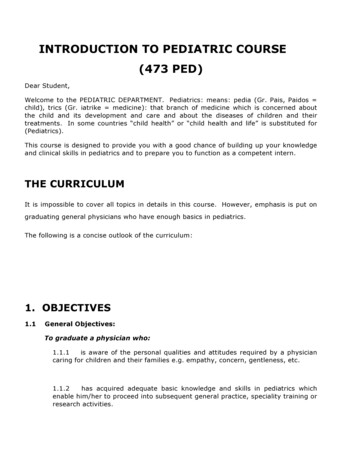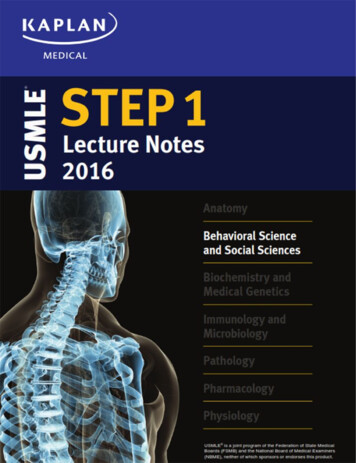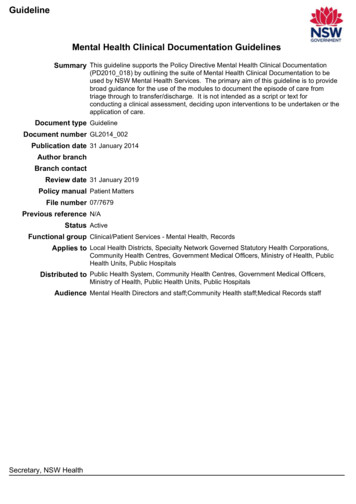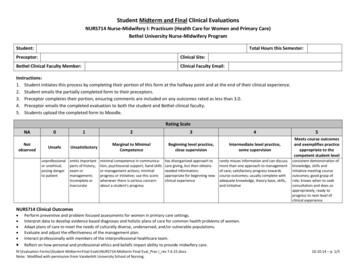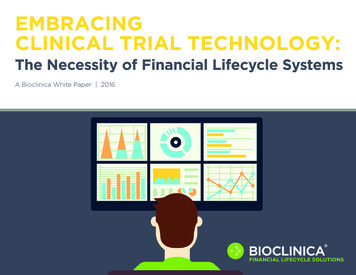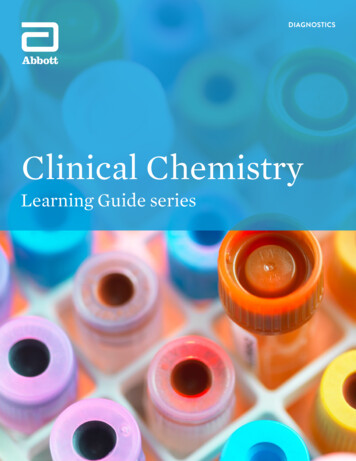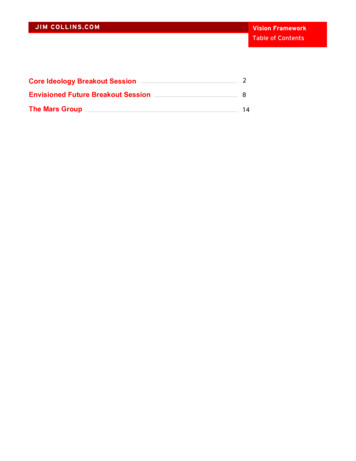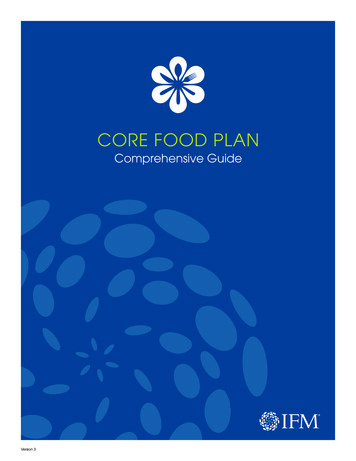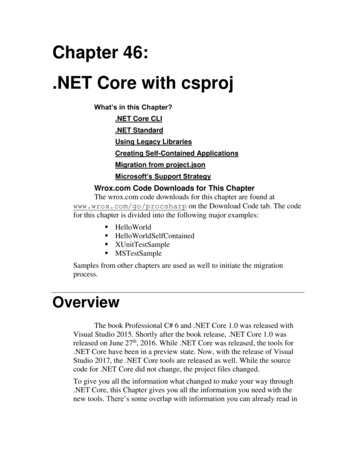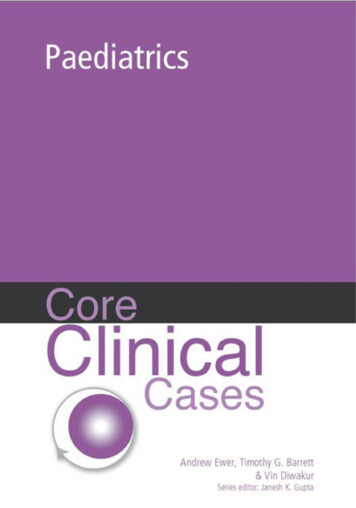
Transcription
CoreClinicalCases In Paediatrics
Core Clinical CasesTitles in the series include:Core Clinical Cases in PaediatricsAuthors: Andrew Ewer, Timothy G. Barrett & Vin DiwakarCore Clinical Cases in PsychiatryAuthors: Tom Clark, Ed Day & Emma C. FergussonComing soon Core Clinical Cases in Basic Biomedical ScienceAuthor: Samy AzerCore Clinical Cases in Obstetrics & Gynaecology 2nd EditionAuthors: Janesh K. Gupta, Gary Mires & Khalid S. KhanCore Clinical Cases in the Medical and Surgical SpecialitiesEdited by Steve Bain & Janesh K. GuptaCore Clinical Cases in Medicine & SurgeryEdited by Steve Bain & Janesh K. Gupta
CoreClinicalCases In PaediatricsA problem-solving approachAndrew Ewer MD MRCP FRCPCHSenior Research Fellow, University of Birmingham;Honorary Consultant Neonatologist,Birmingham Women’s Hospital, Birmingham, UK.Timothy Barrett PhD MRCP MRCPCHHonorary Consultant and Senior Lecturer,Department of Endocrinology,Birmingham Children’s Hospital, Birmingham, UKVin Diwakar MB BS MRCPConsultant Paediatrician, Birmingham Children’s Hospital,Birmingham, UKCore Clinical Cases series edited byJanesh K. Gupta MSc MD FRCOGClinical Senior Lecturer/ Honorary Consultant inObstetrics and Gynaecology, University of Birmingham,Birmingham Women’s Hospital, Birmingham, UKHodder ArnoldA MEMBER OF THE HODDER HEADLINE GROUP
First published in Great Britain in 2005 byHodder Education, a member of the Hodder Headline Group,338 Euston Road, London NW1 3BHhttp://www.hoddereducation.co.ukDistributed in the United States of America byOxford University Press Inc.,198 Madison Avenue, New York, NY10016Oxford is a registered trademark of Oxford University Press 2005 Andrew Ewer, Timothy Barrett and Vin DiwakarAll rights reserved. Apart from any use permitted under UK copyright law,this publication may only be reproduced, stored or transmitted, in any form,or by any means with prior permission in writing of the publishers or in thecase of reprographic production in accordance with the terms of licencesissued by the Copyright Licensing Agency. In the United Kingdom suchlicences are issued by the Copyright Licensing Agency: 90 Tottenham CourtRoad, London W1T 4LP.Whilst the advice and information in this book are believed to be true andaccurate at the date of going to press, neither the author[s] nor the publishercan accept any legal responsibility or liability for any errors or omissionsthat may be made. In particular, (but without limiting the generality of thepreceding disclaimer) every effort has been made to check drug dosages;however it is still possible that errors have been missed. Furthermore,dosage schedules are constantly being revised and new side-effectsrecognized. For these reasons the reader is strongly urged to consult thedrug companies’ printed instructions before administering any of the drugsrecommended in this book.British Library Cataloguing in Publication DataA catalogue record for this book is available from the British LibraryLibrary of Congress Cataloging-in-Publication DataA catalog record for this book is available from the Library of CongressISBN-10: 0 340 81668 6ISBN-13: 978 0 340 81668 41 2 3 4 5 6 7 8 9 10Commissioning Editor: Georgina BentliffProject Editor: Heather SmithProduction Controller: Jane LawrenceCover Design: Georgina HewittIndex: Indexing Specialists (UK) LtdTypeset in 9 on 12 pt Frutiger Light Condensed by Phoenix Photosetting, Chatham, KentPrinted and bound in MaltaWhat do you think about this book? Or any other Hodder Arnold title?Please visit our website at www.hoddereducation.co.uk
ContentsDedicationviSeries PrefaceviiForewordixAbbreviationsxChapter 1Growth problemsChapter 2Developmental delay13Chapter 3Weight faltering (failure to thrive)23Chapter 4Acute severe illness35Chapter 5Acute and chronic fever51Chapter 6Respiratory problems63Chapter 7Fits, faints and funny turns75Chapter 8Headache87Chapter 9Diarrhoea and vomiting97Chapter 10Abdominal pain109Chapter 11Jaundice121Chapter 12Rashes131Chapter 13Poisoning143Chapter 14Emotional and behaviour problems153Index1165
We would like to thank Rachel, Emma and Kate without whose constant support this bookwould not have been written. We would also like to thank Ellen, Sophie, Alice, George, Josephand Lydia for their wonderful drawings.
Series preface‘A History Lesson’Between about 1916 and 1927 a puzzling illness appeared and swept around the world.Dr von Economo first described encephalitis lethargica (EL), which simply meant‘inflammation of the brain that makes you tired’. Younger people, especially women,seemed to be more vulnerable but the disease affected people of all ages. People with ELdeveloped a ‘sleep disorder’, fever, headache and weakness, which led to a prolonged stateof unconsciousness. The EL epidemic occurred during the same time period as the 1918influenza pandemic, and the two outbreaks have been linked ever since in the medicalliterature. Some confused it with the epidemic of Spanish flu at that time while othersblamed weapons used in World War I.Encephalitis lethargica (EL) was dramatised by the film Awakenings (book written by OliverSacks who is an eminent Neurologist from New York), starring Robin Williams and RobertDe Niro. Professor Sacks treated his patients with L-dopa, which temporarily awoke hispatients giving rise to the belief that the condition was related to Parkinson’s disease.Since the 1916-1927 epidemic, only sporadic cases have been described. Pathologicalstudies have revealed an encephalitis of the midbrain and basal ganglia, with lymphocyte(predominantly plasma cell) infiltration. Recent examination of archived EL brain materialhas failed to demonstrate influenza RNA, adding to the evidence that EL was not aninvasive influenza encephalitis. Further investigations found no evidence of viralencephalitis or other recognised causes of rapid-onset parkinsonism. MRI of the brain wasnormal in 60% but showed inflammatory changes localised to the deep grey matter in40% of patients.As late as the end of the 20th century, it seemed that the possible answers lay in theclinical presentation of the patients in the 1916-1927 epidemic. It had been noted by theclinicians at that time that the CNS disorder had presented with pharyngitis. This led to thepossibility of a post-infectious autoimmune CNS disorder similar to Sydenham’s chorea, inwhich group A beta-hemolytic streptococcal antibodies cross-react with the basal gangliaand result in abnormal behaviour and involuntary movements. Anti-streptolysin-O titreshave subsequently been found to be elevated in the majority of these patients. It seemedpossible that autoimmune antibodies may cause remitting parkinsonian signs subsequentto streptococcal tonsillitis as part of the spectrum of post-streptococcal CNS disease.Could it be that the 80-year mystery of EL has been solved relying on the patient’s clinicalhistory of presentation, rather than focusing on expensive investigations? More research inthis area will give us the definitive answer. This scenario is not dissimilar to the controversyabout the idea that streptococcal infections were aetiologically related to rheumatic fever.
viii Series prefaceWith this example of a truly fascinating history lesson, we hope that you will endeavour touse the patient’s clinical history as your most powerful diagnostic tool to make the correctdiagnosis. If you do you are likely to be right 80 to 90% of the time. This is the basis of allthe Core Clinical Cases series, which will make you systematically explore clinical problemsthrough the clinical history of presentation, followed by examination and then theperformance of appropriate investigations. Never break that rule.Janesh Gupta2005
ForewordAs a paediatric student nearly 40 years ago, I went onto the children’s ward of my TeachingHospital for the first time, and picked up a small green textbook, which was mainly a seriesof lists. It helpfully enumerated – without description – 200 causes of abdominal pain inchildren, 150 causes of failure to thrive, and over 100 causes of short stature. Could this bewhat paediatrics was going to be about? Fortunately not. Thankfully, fashions in clinicaleducation have changed, and books of lists are no more.This book represents a much more relevant, context-based approach to teachingpaediatrics and child health, and is one that has proven popular with students inBirmingham over a number of years. Paediatric symptoms from infancy and childhood arepresented, followed by a practical approach to solving them. They have been assembled bya small, expert group of authors and chosen carefully, because they are important – eitherbecause they are frequent, or because the symptom may indicate a serious or dangerousunderlying disorder. The content is relevant to both undergraduate medical students and topostgraduates and probably to nurses in training too. It is not comprehensive – were it tobe, its point would be lost.I am delighted to be able to commend this book to you. It contains a distillate of theauthors’ clinical acumen and wisdom. Consequently, there is hardly a list in sight.Professor Ian BoothLeonard Parsons Professor of Paediatrics and Child HealthThe Medical SchoolEdgbastonBirminghamUK
AbbreviationsADHantidiuretic hormoneALTalanine aminotransferaseASOanti-streptolysin OASTaspartate aminotransferaseCMVcytomegalovirusDATdirect antibody testESRerythrocyte sedimentation rateFBCfull blood countFSHfollicle-stimulating hormoneg-GTγ-glutamyl transferaseG-6PDglucose 6-phosphate dehydrogenaseGNRHgonadotrophin-releasing hormoneHSPHenoch–Schönlein purpura.IGFinsulin-like growth factorITPidiopathic thrombocytopenic purpuraITUintensive therapy unitLHluteinizing hormoneLHRHluteinizing hormone-releasing hormoneLRTIlower respiratory tract infectionNAInon-accidental injuryPEFRpeak expiratory flow rateRSVrespiratory syncytial virusSIADHsyndrome of inappropriate ADHTORCHscreen for Toxoplasma, Rubella, Cytomegalovirus, Herpes simplexURTIupper respiratory tract infectionUTIurinary tract infection
1Growth problemsQuestionsClinical casesKey conceptsAnswers
2 Growth problems? Questions for each of the clinical casesQ1:Q2:Q3:Q4:Q5:Q6:What is the likely differential diagnosis?What issues in the given history support the diagnosis?What additional features in the history would you seek to support a particular diagnosis?What clinical examination would you perform, and why?What investigations would be most helpful, and why?What treatment options are appropriate?Clinical casesCASE 1.1 – My 6-year-old son is the shortest in his class.A 6-year-old boy was seen in the paediatric outpatient department. His parents complained that he was the shortest boy inhis class, and he could not reach the coat pegs in school. On examination, the child’s height was 106 cm (3rd centile).CASE 1.2 – My 5-year-old daughter is developing breasts.A 5-year-old girl was referred to outpatients because of early breast development. This had been present since birth, but isincreasing. She was on no medication. On examination, her height was 117 cm (98th centile). Breast development wasTanner stage 2.CASE 1.3 – My 14-year-old daughter has not yet started her periods.A 14-year-old girl was referred for investigation of delayed puberty. She was born at full term, after a normal pregnancy.Her general development was normal, and she attended a mainstream school. On examination, she was prepubertal.
OSCE counselling cases 3OSCE counselling casesOSCE COUNSELLING CASE 1.1 – Can you give my son something to make him taller?OSCE COUNSELLING CASE 1.2 – Why is my child overweight?
4 Growth problemsKey conceptsIn order to work through the core clinical cases in this chapter, you will need to understand the following key concepts.Phases of childhood growthz Infancy phase: from birth to 2–3 years, the fastest period of growth. It is determined mainly by nutrition.z Childhood phase: from 2–3 years to the onset of puberty, and is determined mainly by hormones, including growthhormone, thyroxine and insulin.z Adolescent growth spurt: occurs from the onset of puberty to fusion of the epiphyses, and is determined by thesynergistic action of growth hormone and sex hormones (androgens and oestrogens).Fusion of epiphysesA gradual process initiated by the secretion of oestrogen from the adrenals in boys and ovaries in girls. Epiphyseal fusionlimits final adult height.Precocious pubertyThe development of secondary sexual characteristics before the ages of 8 years in females and 9 years in males. Oneexample is thelarche, which is the isolated development of breast tissue without pubic or axillary hair development.Delayed pubertyThe absence of pubertal development by 14 years of age in females and 15 years in males.Tanner stagingThe classification of pubertal development according to the appearance of pubic hair in males and females, breastdevelopment in females, and external genital development in males. Stage 1 is prepubertal, stage 5 is adult.OrchidometerA series of beads of increasing size from 2 mL volume to 24 mL volume used to assess testicular size. Testicular volumeincreases in proportion to testosterone secretion. Volumes of 2–3 mL equates to prepubertal testicular size; 12 mL volumeis attained at the time of maximum height velocity. From 12 mL upwards is normal for male adults.Measurement of height and height velocityz To determine the true height velocity, children should have their height measured on two occasions at least 6 monthsapart. This reduces measurement inaccuracies due to observer error. The accuracy of a single height measurement is 0.5 cm. Inter-observer error is similar. To minimize these errors, the height should be measured by the same person,on the same equipment, with a minimum interval of 6 months.
Key concepts 5z The height attained over a 6-month period can be doubled to express a height velocity in cm per year. Centile chartsexist for height velocity. A child’s height velocity needs to remain above the 25th centile in order to maintain thecentile on a linear growth chart.z Height velocity below the 25th centile for at least 18 months equates to a child drifting down the centiles on a lineargrowth chart, and is one definition of growth failure.Estimation of final adult height from parents’ height (mid-parental height)To estimate a boy’s final height, add 12.5 cm to mother’s height and take the mean of the mother’s adjusted height andthe father’s height (mid-parental height). For a girl’s final height, subtract 12.5 cm from the father’s height and take themean of the adjusted father’s height and the mother’s height. The 95 per cent confidence limits for the child’s predictedadult height are the mid-parental height 8 cm.Turner syndromez A common cause of short stature in girls, with a prevalence of about 1 in 5000. It is caused by the absence of one ofthe sex chromosomes, giving a karyotype of 45XO.z Features include short stature, web neck, wide carrying angle at the elbow, convex nails, shield-shaped chest, lowposterior hairline, ovarian dysgenesis (defective development), and normal intelligence (but sometimes difficulty insocialization).z Girls with Turner syndrome are relatively growth hormone-resistant, but they do benefit from growth hormonetreatment, which can increase their final height by about 5 cm.z These girls also need hormone replacement in the form of oestrogens to induce puberty.z Many children and parents benefit by getting in touch with a family support group such as the Child GrowthFoundation.
6 Growth problemsAnswersCASE 1.1 – My 6-year-old son is the shortest in his class.Q1: What is the likely differential diagnosis?A1z Familial short stature.z Constitutional delay of growth.z Psychosocial causes of short stature.z Isolated growth hormone deficiency.Q2: What issues in the given history support the diagnosis?A2The boy is on the third centile for height, which means that 3 per cent of the population of 6-year-olds are shorter thanhim. He is within the normal range of height for a UK population. Consequently, he is likely to be a short, normal boy.AQ3: What additional features in the history would you seek to support aparticular diagnosis?A3z Ask how long the parents have been worried, i.e. has he always been short or small; is there any history of chronicillness? (e.g. coeliac disease (q.v.), heart or kidney disease)z Was he a normal birth and delivery? (ask about birthweight). Was he born premature or growth restricted?(constitutional short stature)z What ethnic group is the family from? (ethnic differences in height) How tall are his parents? (familial short stature)z What is the social background and family relationships? (emotional neglect or other forms of child abuse are causes ofpsychosocial short stature)z Is he falling behind his peers? (height falling off centiles as in growth hormone deficiency)Q4: What clinical examination would you perform, and why?A4z Measure his parents’ height and plot them on the growth chart.z Estimate mid-parental height.
Answers 7Q5: What investigations would be most helpful, and why?A5z Take serial height measurements at least 6 months apart.z Calculate height velocity. If height velocity is below 25th centile over 6 months, other investigations would include:zMeasurement of insulin-like growth factor-1 (IGF1) as a surrogate marker of growth hormone.zX-ray of the left wrist to ascertain bone age or skeletal maturity. This is delayed in growth hormone deficiency.Other causes of bone age delay include hypothyroidism and coeliac disease.zGrowth failure is an indication for formal pituitary testing with a dynamic growth hormone stimulation test suchas the insulin stress test in which a small dose of insulin is given to induce hypoglycaemia. This is a potentstimulus for growth hormone secretion, and serial measurements assess the peak secretion.Q6: What treatment options are appropriate?A6z The most likely diagnosis is familial short stature. No treatment is necessary, but reassurance that the child is normal.z Constitutional short stature is usually not amenable to treatment, although some children with Russell Silver syndrome(a disorder of short stature, hemihypertrophy, incurved little fingers, and triangular shaped face) do benefit fromgrowth hormone therapy.z Psychosocial short stature will respond to elimination of the causes of emotional neglect or other forms of child abuse.This may require removal of the child from the abusing environment.CASE 1.2 – My 5-year-old daughter is developing breasts.Q1: What is the likely differential diagnosis?A1z Isolated thelarche.z Thelarche variant.z Precocious puberty.Q2: What issues in the given history support the diagnosis?A2The child is not on any medication, and some breast development has been present since birth.
8 Growth problemsAQ3: What additional features in the history would you seek to support aparticular diagnosis?A3z Ask whether parents have noticed any pubic hair or unusual mood swings (precocious puberty). In addition, has thechild been growing rapidly over the past 1–2 years, as in an adolescent growth spurt?z Has anyone else in the family had early breast development? Did this progress to precocious puberty?Q4: What clinical examination would you perform, and why?A4z Plot the growth on a height and weight chart, together with previous measurements to gauge her height velocity. Arapid height velocity would suggest an adolescent growth spurt, and precocious puberty. Check mid-parental height.z Examine for pubic and axillary hair – again, signs of precocious puberty – and perform an abdominal examination formasses.z Consider neurological examination. Intra-cranial tumours are a rare cause of precocious puberty, more common inboys, and usually resulting in disconsonant puberty (pubic hair without testicular enlargement).Q5: What investigations would be most helpful, and why?A5z If there are no other signs of puberty, then isolated premature thelarche is the most likely diagnosis. This is a benigncondition, and may not require follow-up. Parents can be instructed to contact the doctor again if further signs ofpuberty develop.z If the child’s height is above the expected centile for the parents’ height, then serial measurements of growth arerequired to detect a premature growth spurt. In addition, a bone age X-ray will give an indication of possible advancedbone age. If the bone age is advanced in the absence of other signs of puberty, the child fits into the category ofthelarche variant. These children are at risk of developing precocious puberty, and require follow-up.z The presence of other signs of puberty such as pubic hair, warrants further investigations. These include a pelvicultrasound for ovarian follicles and uterine size, and a luteinizing hormone-releasing hormone (LHRH) test. An injectionof LHRH is given, and luteinizing hormone (LH) and follicle-stimulating hormone (FSH) measured at time points after.The magnitude of the rise in LH and FSH indicates whether the child is prepubertal, in early puberty, or establishedpuberty. True precocious puberty is usually of central origin at the level of the hypothalamus, and the cause isunknown.Q6: What treatment options are appropriate?A6z The most likely diagnosis is isolated premature thelarche. In this situation, the parents can be reassured and the childdoes not need to be followed-up.
Answers 9z If thelarche variant is present, the child needs follow-up as she is at risk of precocious puberty.z If precocious puberty is present, it is important to delay further progression to avoid compromising final height, and toprevent the onset of menarche in primary school. The available treatment is depot injection of a gonadotrophinreleasing hormone agonist such as goserelin. This acts by down-regulating the release of LH and FSH from the anteriorpituitary, and may regress pubertal signs.CASE 1.3 – My 14-year-old daughter has not yet started her periods.Q1: What is the likely differential diagnosis?A1z Familial delayed puberty.z Turner syndrome.z Systemic illness.z Anorexia nervosa.Q2: What issues in the given history support the diagnosis?A2This girl is presumably of normal development and intelligence as she attends a mainstream school. Age at menarche has alarge genetic component, and tends to run in families. However, Turner syndrome must be excluded.AQ3: What additional features in the history would you seek to support aparticular diagnosis?A3z Ask about mum’s age at menarche, and the ages of menarche of any sisters.z Is the girl short compared to her peers? (Turner syndrome)z Does she have any chronic illness such as cystic fibrosis (q.v.) that would explain her delayed puberty?z Are there any factors in the social history that would lead you to suspect anorexia (pressure of examinations, unusualfixation with food, unwillingness to develop adult interests and behaviour).Q4:What clinical examination would you perform, and why?A4z Plot height and weight on a growth chart. Check the parents’ height.z Look for short stature in relation to parents’ heights (Turner) and underweight for height (anorexia).
10 Growth problemsz Assess her pubertal stage. Is she prepubertal? (the commonest situation in Turner)z Does she have hyperteleorism, web neck, wide carrying angle of the arms, shield chest, hypoplastic nails,underdeveloped nipples, or other signs of Turner syndrome?Q5: What investigations would be most helpful, and why?A5z Chromosome karyotype. The normal female complement should be 46XX. Turner girls are usually mosaic (i.e. they havea mixture of cells, some normal 46XX karyotype, some 45XO karyotype).z LHRH test (q.v.). This will establish if the hypothalamo-pituitary-gonadal axis is intact, and exclude primary gonadalfailure.z X-ray the left wrist for bone age. Look for delayed bone age in most causes of delayed puberty.Q6: What treatment options are appropriate?A6z If the diagnosis is familial delayed puberty, the girl can be reassured that she will achieve a final adult height withinthe range predicted by her parents’ heights.z Girls with Turner syndrome need genetic counselling.z If a systemic illness is diagnosed, then specific treatment will be required.z Anorexia nervosa is a life-threatening condition that needs specialist child psychiatry input.
OSCE counselling cases 11OSCE counselling casesOSCE COUNSELLING CASE 1.1 – Can you give my son something tomake him taller?This is a common question asked by parents of short and not-so-short children.z Children who are ‘short normal’ – i.e. due to familial short stature or constitutional short stature – do not needtreatment other than reassurance that they are healthy. Trials of growth hormone in short normal children have notshown any appreciable increase in final adult height. Growth hormone is indicated for growth hormone deficiency,Turner syndrome, Prader–Willi syndrome, Russell–Silver syndrome and in chronic renal failure.z If growth hormone is indicated, the child and parents should be counselled about its use. Growth hormone isadministered by daily subcutaneous injection until the child’s height velocity falls below 2 cm per year (usually untilmid-late teens).z The family may wish to contact a parent support group such as the Child Growth Foundation.z Regular monitoring of the child’s growth is required to assess compliance and the effects of treatment.z Many children with isolated growth hormone deficiency recover normal growth hormone secretion by puberty. They allneed retesting at the end of the growth period.z The benefit of exogenous growth hormone in growth hormone-deficient adults is controversial; there is some evidencethat it improves general well-being and cardiac muscle contractility. However, this must be balanced against the costof this very expensive drug.OSCE COUNSELLING CASE 1.2 – Why is my child overweight?Children are often brought to general paediatric clinics because of obesity.z Find out in the history if there is any indication of pathology such as tiredness and lethargy in hypothyroidism, growthfailure in Cushing’s syndrome (very rare in children). Enquire about diet and exercise, and look at the phenotype of theparents (are the parents overweight as well?).z Measure blood pressure, assess fat distribution (uniform in exogenous obesity), abdominal striae, acanthosis nigricans(sign of insulin resistance).z The most likely diagnosis is exogenous obesity. This frequently induces more rapid growth and some advance in boneage. The family needs to be reassured that there is no underlying pathology.z Explain that weight is determined by the balance of calorie intake and energy expenditure.z Give dietary advice to reduce the fat content in the diet, reduce salt and increase fibre.z Give exercise advice and suggest 30 minutes of exercise that makes the child breathless, every day.z Set realistic targets for weight, and give positive encouragement.
This page intentionally left blank
2Developmental delayQuestionsClinical casesKey conceptsAnswers
14 Developmental delay? Questions for each of the clinical casesQ1:Q2:Q3:Q4:Q5:Q6:What is the likely differential diagnosis?What issues in the given history support the diagnosis?What additional features in the history would you seek to support a particular diagnosis?What clinical examination would you perform and why?What investigations would be most helpful and why?What treatment options are appropriate?Clinical casesCASE 2.1 – My newborn baby is very ‘floppy’ (hypotonic).A 2-day-old baby is noted to have very poor tone and is floppy (like a rag doll). He is feeding rather slowly, but there are noother symptoms. The limbs move spontaneously.CASE 2.2 – My 9-month-old baby is not yet sitting and has stiff arms and legs.A 9-month-old girl has been increasingly noted to hold her arms and legs out straight, with occasional crossing-over of thelegs at the ankles. She does not sit unsupported, nor does she roll over effectively. She was born 12 weeks premature andwas very ill during the neonatal period.CASE 2.3 – My 2-year-old daughter does not say any recognizable words.A 2-year-old girl who is otherwise developing normally does not say any words which are recognizable. She is a third child,and her siblings’ speech development was normal.
OSCE counselling cases 15OSCE Counselling CasesOSCE COUNSELLING CASE 2.1 – My 16-month-old son is not yet walking.OSCE COUNSELLING CASE 2.2 – My newborn baby has been diagnosed with Down’ssyndrome. What does this mean for her?
16 Developmental delayKey conceptsIn order to work through the core clinical cases in this chapter, you will need to understand the following key concepts.Normal infant developmentz From birth, babies develop new skills as they get older.z These skills can be divided into five main groups: Gross motor (e.g. sitting, walking); (ii) Fine motor (e.g. holding anobject, drawing a shape); (iii) Hearing and speech; (iv) Cognitive (thinking, understanding); and (v) Social (interactionwith others).Developmental milestonesz These are specific skills that most infants will achieve by a certain age (e.g. smiling to social overtures at 6 weeks ofage, sitting unsupported at 8 months of age).z Milestones are subdivided into the major development groups described above. It must be emphasized that althoughmost infants will achieve milestones around the same time, some milestones will have a significant variation (e.g.walking unsupported usually occurs around 13 months, but may be achieved as early as 11 months or as late as 18months in normal children).Developmental delayz This is defined as a significant delay in achieving developmental milestones which is outside the normal variation.z Delay may occur in one, some or all of the developmental skills groups.Cerebral palsyz Cerebral palsy (CP) is a chronic disorder of muscle tone and movement due to a non-progressive injury to thedeveloping brain.z CP can result from a number of condi
This book represents a much more relevant, context-based approach to teaching paediatrics and child health, and is one that has proven popular with students in Birmingham over a number of years. Paediatric symptoms from infancy and childhood are presented, followed by a pract
